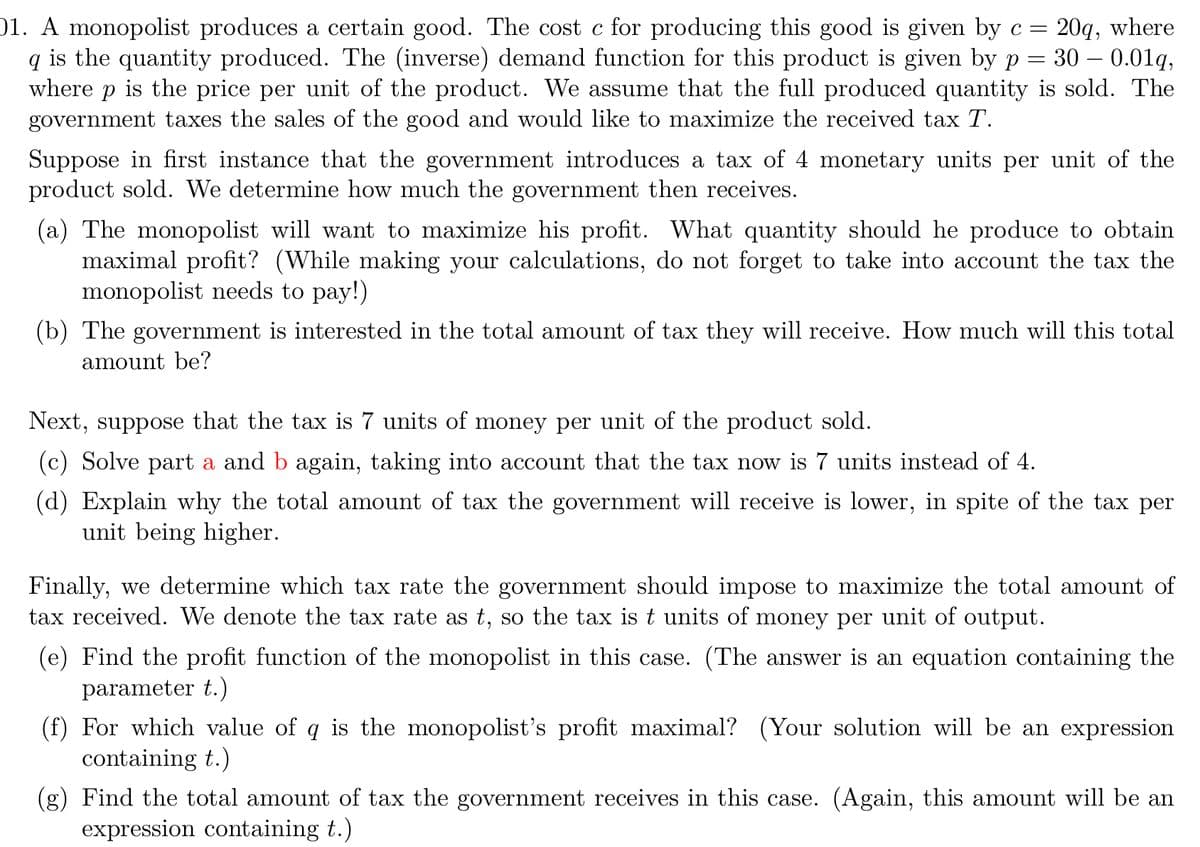A monopolist produces a certain good. The cost c for producing this good is given by c = 20q, where q is the quantity produced. The (inverse) demand function for this product is given by p = = 30 - 0.019, where p is the price per unit of the product. We assume that the full produced quantity is sold. The government taxes the sales of the good and would like to maximize the received tax T. Suppose in first instance that the government introduces a tax of 4 monetary units per unit of the product sold. We determine how much the government then receives. (a) The monopolist will want to maximize his profit. What quantity should he produce to obtain maximal profit? (While making your calculations, do not forget to take into account the tax the monopolist needs to pay!) (b) The government is interested in the total amount of tax they will receive. How much will this total amount be? Next, suppose that the tax is 7 units of money per unit of the product sold. (c) Solve part a and b again, taking into account that the tax now is 7 units instead of 4.
A monopolist produces a certain good. The cost c for producing this good is given by c = 20q, where q is the quantity produced. The (inverse) demand function for this product is given by p = = 30 - 0.019, where p is the price per unit of the product. We assume that the full produced quantity is sold. The government taxes the sales of the good and would like to maximize the received tax T. Suppose in first instance that the government introduces a tax of 4 monetary units per unit of the product sold. We determine how much the government then receives. (a) The monopolist will want to maximize his profit. What quantity should he produce to obtain maximal profit? (While making your calculations, do not forget to take into account the tax the monopolist needs to pay!) (b) The government is interested in the total amount of tax they will receive. How much will this total amount be? Next, suppose that the tax is 7 units of money per unit of the product sold. (c) Solve part a and b again, taking into account that the tax now is 7 units instead of 4.
Microeconomics A Contemporary Intro
10th Edition
ISBN:9781285635101
Author:MCEACHERN
Publisher:MCEACHERN
Chapter9: Monopoly
Section: Chapter Questions
Problem 1QFR
Related questions
Question
A monopolist produces a certain good. The cost c for producing this good is given by c = 20q, where
q is the quantity produced. The (inverse) demand function for this product is given by p = 30 − 0.01q,
where p is the price per unit of the product. We assume that the full produced quantity is sold. The
government taxes the sales of the good and would like to maximize the received tax T .
Suppose in first instance that the government introduces a tax of 4 monetary units per unit of the
product sold. We determine how much the government then receives.

Transcribed Image Text:=
01. A monopolist produces a certain good. The cost c for producing this good is given by c = 20q, where
qis the quantity produced. The (inverse) demand function for this product is given by p 30 – 0.01q,
where p is the price per unit of the product. We assume that the full produced quantity is sold. The
government taxes the sales of the good and would like to maximize the received tax T.
Suppose in first instance that the government introduces a tax of 4 monetary units per unit of the
product sold. We determine how much the government then receives.
(a) The monopolist will want to maximize his profit. What quantity should he produce to obtain
maximal profit? (While making your calculations, do not forget to take into account the tax the
monopolist needs to pay!)
(b) The government is interested in the total amount of tax they will receive. How much will this total
amount be?
Next, suppose that the tax is 7 units of money per unit of the product sold.
(c) Solve part a and b again, taking into account that the tax now is 7 units instead of 4.
(d) Explain why the total amount of tax the government will receive is lower, in spite of the tax per
unit being higher.
Finally, we determine which tax rate the government should impose to maximize the total amount of
tax received. We denote the tax rate as t, so the tax is t units of money per unit of output.
(e) Find the profit function of the monopolist in this case. (The answer is an equation containing the
parameter t.)
(f) For which value of q is the monopolist's profit maximal? (Your solution will be an expression
containing t.)
(g) Find the total amount of tax the government receives in this case. (Again, this amount will be an
expression containing t.)
Expert Solution
This question has been solved!
Explore an expertly crafted, step-by-step solution for a thorough understanding of key concepts.
Step by step
Solved in 5 steps with 7 images

Knowledge Booster
Learn more about
Need a deep-dive on the concept behind this application? Look no further. Learn more about this topic, economics and related others by exploring similar questions and additional content below.Recommended textbooks for you


Managerial Economics: Applications, Strategies an…
Economics
ISBN:
9781305506381
Author:
James R. McGuigan, R. Charles Moyer, Frederick H.deB. Harris
Publisher:
Cengage Learning



Managerial Economics: Applications, Strategies an…
Economics
ISBN:
9781305506381
Author:
James R. McGuigan, R. Charles Moyer, Frederick H.deB. Harris
Publisher:
Cengage Learning



